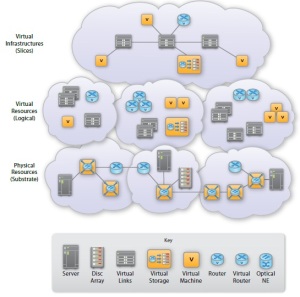R&E Network Model of the Future?
September 13, 2011 1 Comment
Contributing author: Bill St. Arnaud
There is a growing momentum among the major Research & Education (R&E) networks around the world to move to Open Lightpath Exchanges (OLEs where, as Cees de Laat explains, hybrid networks meet to:
- exchange traffic
- facilitate international interconnections
- minimize quantity of colo, equipment and cards required
- minimize call blocking probability at optical exchange points
OLEs will fundamentally change the future of R&E networking. At the spring 2011 Internet2 meeting and in follow-up discussion at the Terena meeting, a joint statement was drafted representing the views of many of the attendees on why OLEs are so critical to the future of R&E networking and represent significant opportunity for network innovation.
OLEs Allow Choice
OLEs will allow individual institutions, even researchers to directly peer with each other with no policy constraints and eliminate or minimize the need for a traditional “network.” Point-to-point links will still be required

Virtual Infrastructure: The diagram above shows how virtual infrastructures are created. They are assembled by creating « slices » of the physical substrates, which are then aggregated into a working virtual infrastructure from which services can be delivered. The physical infrastructure consists mainly of servers, disc arrays and network elements such as switches and routers, whereas the virtual infrastructure consists of virtual machines, virtual storage, virtual routers and virtual switches. (Image courtesy: GreenStar Network)
between exchange points and these will need to be provisioned through a variety of means. But now it is the choice of those who connect to the OLE, whether it is an institution, researcher or virtual organization, to compose their own network topology.
As some of you may remember this was one of the original concepts of the CA*net 3/CA*net 4 (CANARIE) architecture and drove the design of Universal Commerce Language and Protocol (UCLP). I am pleased to see that Internet2’s Open Science, Scholarship and Services Exchange (OS3E) (http://www.internet2.edu/network/ose/) is a similar strategy in this regard.
The driver for these developments, of course, is the demand of big science. But just as importantly OLEs will enable a new wave in network innovation with such new concepts as “software defined networks,” “Just in time networking,” “network as a service,” “pay as you go networking,” etc. OLE architecture is also a fundamental underpinning for zero carbon networks like the GreenStar Network which is based on a hub (OLE) and spoke model.
Financial Challenges
No question OLEs may cause serious financial challenges for many regional networks and NRENs, as institutions and researchers need only pay for direct costs of interconnecting at an OLE as opposed to a bundled membership package.
But I still believe there will be a critical role for R&E networks of all types. In the future the major focus of their revenue I believe will not be in provisioning pipes or IP networks, but in new network services such as national 5G wireless initiatives, content peering and distribution, outsourcing campus IT and managing science DMZ, energy CO2 reduction services in relocating data centers to remote locations, supporting continent-wide or global cyber-infrastructure or e-Infrastructure.
What are the implications of the OLE concept for Canadian R&E networks?
Bill St. Arnaud, formerly a Chief Research Officer at CANARIE, is a Green IT consultant who works with clients on a variety of subjects such as the next generation Internet and practical solutions to reduce GHG emissions such as free broadband and electrical highways. He currently also works as a consultant at CANARIE.

Hi Bill,
Nice to see you’ve found a place to nail down these kind of discussions.
I’m with you that so far as OLE are concerned “The driver for these developments, of course, is the demand of big science”. The concern I have is that network operators are all NR and no EN.
We seem to have this disconnect where the fat boys are off going on about tomorrow, while all the skinnies are left to the “commodity providers”. So at one end we have the CERNs, LIGOs, etc trying, independently and occasionally, to educate global students – the great unwashed – about their groundbreaking experiments. (Check out the classrooms attached to their sites.) At the other end we have teachers trying to figure how to prepare students for a globalized world.
We live in a world where the networks operators are attempting to move from supporting national Institutions to one which provides an infrastructure for global disciplinary groups; both fatties and skinnies. More likely, for both. In between are a bunch of institutional IT guys who are considered a “human firewall” by one of my favourite correspondents = director of apps for an NREN.
So yes, NRs do have a role to play as geeks push the frontiers of fat science. But I think it’s time to explain how the EN part of the OLE equation is going to effect the rest of the world. Otherwise we’ll have a lot of human firewalls who are going to resist change,, in all sorts of institutions. (http://www.youtube.com/watch?v=Bov7UiyJacA&feature=related )